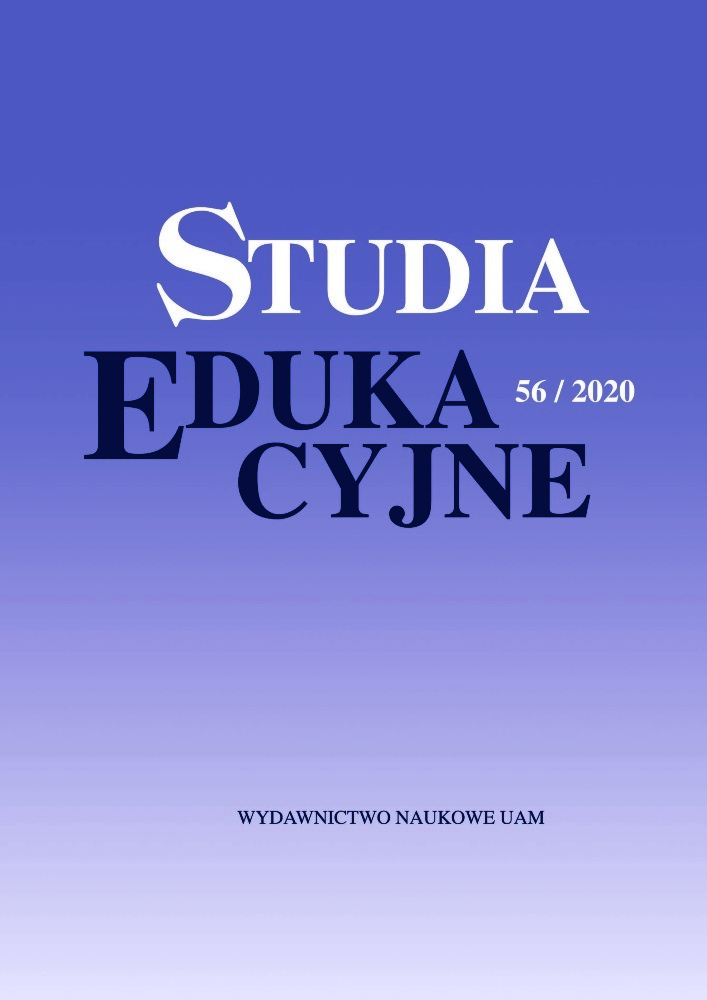Abstrakt
Diala Abu-Oksa Eid, The Arab Educational System in Israel: Challenges and Changes [Arabski system szkolnictwa w Izraelu – wyzwania i zmiany]. Studia Edukacyjne nr 56, 2020, Poznań 2020, pp. 435-448. Adam Mickiewicz University Press. ISSN 1233-6688. DOI: 10.14746/se.2020.56.24
While the Arab minority in Israel has suffered greatly from war events and political definition of the state, its education system has experienced rapid development since the state’s establishment until today. The partial improvement in the level of education of Arab children and youth is evident in qualitative and quantitative indices, as well as in the level of infrastructure of the Arab education system. Nevertheless, socio-economic gaps between Arab and Jewish children and youth continue to exist, and it is apparent that the rate of improvement does not keep pace with the growing needs of Arab society in the field of education. In the last decade, the government has adopted a series of five-year plans for the socio-economic development of Arab minority. However, there is a significant gap between Arab education and Hebrew education in important indicators, such as financial investment per pupil, infrastructure (buildings and classrooms), educational frameworks outside the school hours, and the rate of entitlement to matriculation.
At the beginning of the eighth decade of the State of Israel, the real challenge of the Arab education system in Israel is not necessarily quantitative, but qualitative. The more formal and informal educational programs in the Arab educational system will be adapted to the culture of the children and youth integrated into it, the more Arab society will be able to realize its human potential.
Bibliografia
Abu-Asbah H., Fresco B., Abu-Nasra, Dropout of pupils in Arab, Bedouin and Druze education: summary report, Ministry of Education 2013.
Abu-Lughod L., Foreword, [in:] Displaced at home: Ethnicity and gender among Palestinians in Israel, Eds. R.A. Kanaaneh, I. Nusair, NY:SUNY Press, New York 2010.
Agbaria A., Informal Education in Palestinian Society in Israel, [in:] Informal Education in a Changing Reality, Eds. S. Rumi, M. Shmida, The Magnes Press, Jerusalem 2007.
Al-Hajj M., Education among Arabs in Israel: Control and Social Change, The Magnes Press, Jerusalem 1996.
Arar K., Ibrahim F., Education for national identity: Arab school principals and teacher dilemmas and coping strategies, Journal of Education Policy, 2016, 31(6).
Arlosoroff M., An Arab child is equal to a ninth of a Jewish child, The Marker 9.1.2016.
Blas N., The scholastic achievements of Arab students, Taub Center for Social Policy Studies in Israel, Jerusalem 2017.
Central Bureau of statistics, 2018. Yearly report, Israeli Ministry of Interior Affairs, Jerusalem.
Diab K., Mi’ari M., Collective identity and readiness for social relations with Jews among Palestinian Arab students at the David Yellin Teacher Training College in Israel, Intercultural Education, 2007, 18(5).
Dichter S. (Ed.), Monitoring civic equality between Arab and Jewish citizens of Israel, Sikkuy Report, Sikkuy, The Association for the Advenced of Civic Equality, Jersusalem 2003-2004. (Hebrew)
Ghanem A., Rouhana N., Citizenship and the parliamentary politics of minorities in an ethnic state: The Palestinian citizens in Israel, Nationalism and Ethnic Politics, 2001, 7(1).
Government decision. Decision no. 922, Israeli Government, Jerusalem 2016.
Gra R. (Ed.), Book of Arab Society in Israel (8): Population, Society, Economy, The Van Leer Institute, Jerusalem 2016.
Haddad Haj Yahya N., Rudnitzky A., Informal Education in Arab Society: Vision and Practice, The Israel Democracy Institute, Jerusalem 2018.
Harpaz Y., A state does not make peace with its citizens, The Echo of Education, 2011 February.
Jabarin Y., Vagabaria A., Education on Hold: Government Policy and Civil Initiatives to Promote Arab Education in Israel, Dirasat, Arab Center for Law and Policy, Nazareth 2010.
Karakra Ibrahim A., A Drop in the Arab Education System, [in:] Arab Youth in Israel: Between Chance and Risk, Eds. E. Reches, A. Rodnitzky, Tel Aviv University, Konrad Adenauer Program for Jewish-Arab Cooperation, Tel Aviv 2008.
Khamaise R. (Ed.), Arab society in Israel (3), Population, society, economy, Van Leer Institute, Jerusalem 2009.
Knesset website: http:// www.knesset.gov.il
Ministry of Social Affairs website, http://www.btl.gov.il
Morris B., The Birth of the Palestinian refugee’s problem, 1947-1949, Israel: Am Oved, Tel Aviv 1991. (Hebrew)
Pappé I., The forgotten Palestinians: A history of the Palestinians in Israel, CT: Yale University Press, New Haven 2011.
Reches A., Dilemmas of education in mixed cities, [in:] Together but Together: Mixed Cities in Israel, Ed. A. Reches, Tel Aviv University, Konrad Adenauer Program for Jewish-Arab Cooperation, Tel Aviv 2007.
Reiter Y., Cohen A. (Eds.), Information Bulletin: Arab Society in Israel, Second Edition, The Abraham Fund Initiatives, Neve Ilan 2012.
Rodnitzky A., Arab citizens of Israel at the beginning of the twenty-first century, The Institute for National Security Studies, Tel Aviv 2014.
Rodnitzky A., The Arab minority in Israel and the discourse on a “Jewish state”, The Israel Democracy Institute, Jerusalem 2015.
Rouhana N., Identities in conflict: Palestinian citizens in an ethnic Jewish State, CT: Yale University Press, New Haven 1997.
Suwaed M., Encouraging Socio-Ethnic Pluralism in Arab High Schools in Israel: Perspective of the Headmistress and Educational Staff, International Education Studies, 2014, 7(4).
Suleiman R., Perception of the minority’s collective identity and voting behavior: The case of Palestinians in Israel, Journal of Social Psychology, 2002, 142(6).
The face of Israeli society: Israel from where and where? (2013), Report No. 6, Central Bureau of Statistics.
The State Education Law, 5713-1953, Amendment No. 6, 2003, was published from: https://www.nevo.co.il/law_html/Law01/152_024.html.
Vinegar A., Data on the distribution of the Ministry of Education budget to schools by sector, The Knesset Research and Information Center, Jerusalem 2015.
Website of the Central Bureau of Statistics: http://www.cbs.gov.il
Weiss A., State of Israel: Social and Economic Charts in Israel 2017, Taub Center, Jerusalem 2017.
Yogev A., Approaches to moral education in a pluralistic society, [in:] Junction: Values in education in Israeli society, Eds. I. Iram, S. Shkolnikov, I. Cohen, A. Schechter, The Ministry of Education, Jerusalem 2001.
Yona Y., Shenhav Y., What is multiculturalism, Israel: Babel, Tel Aviv 2005. (Hebrew)

